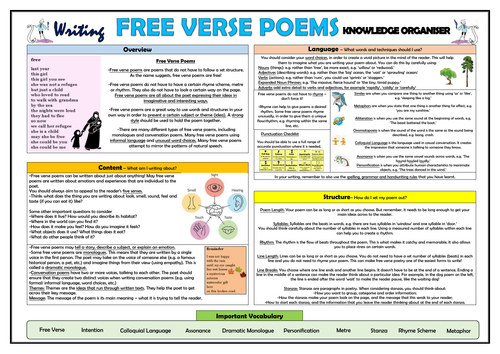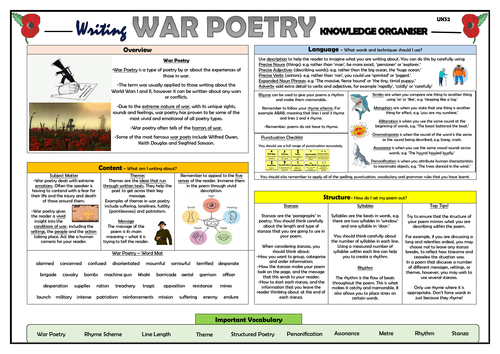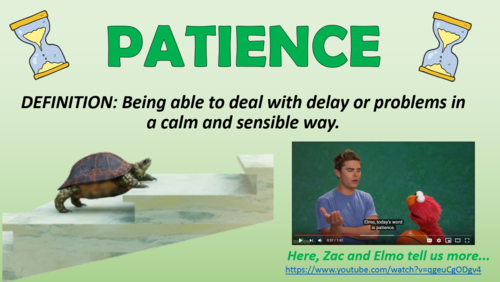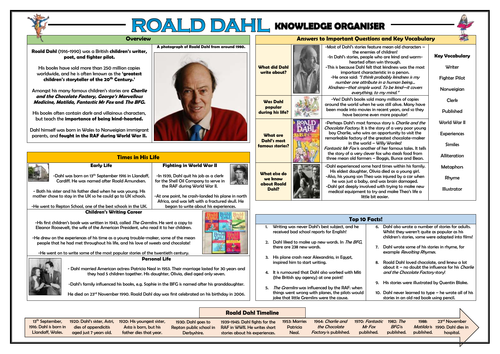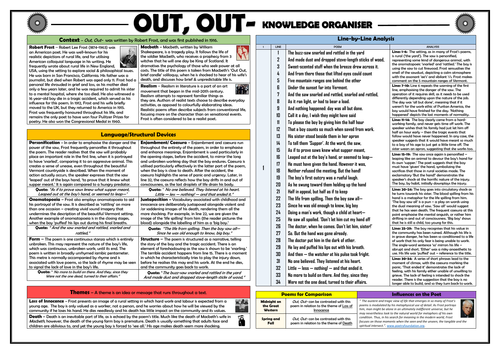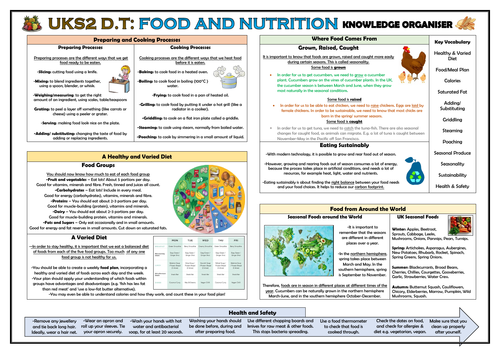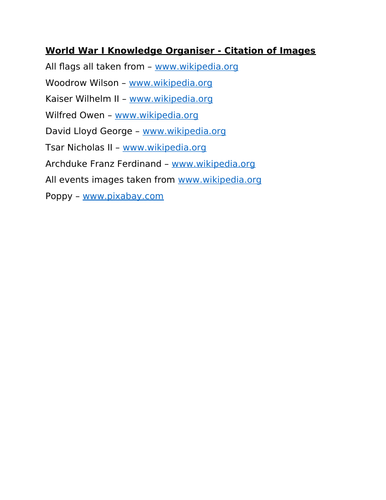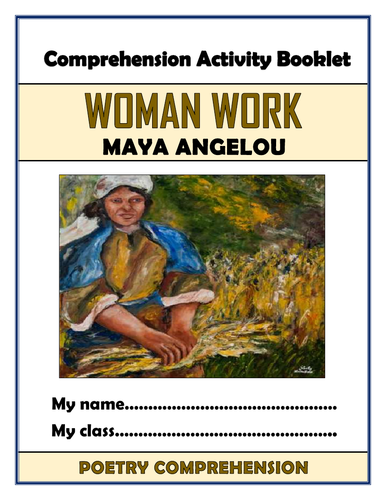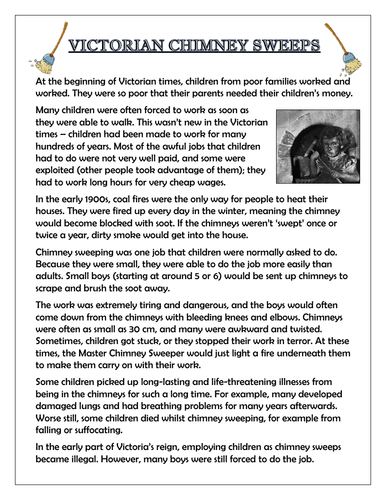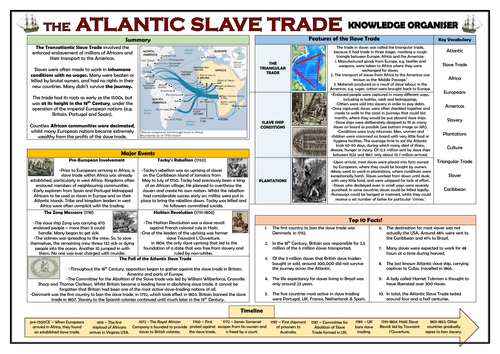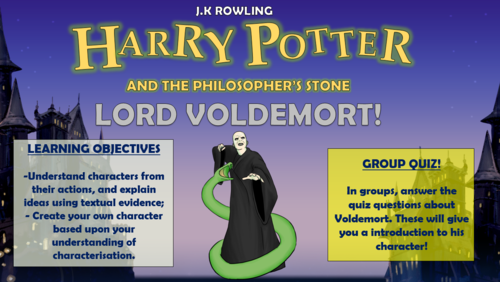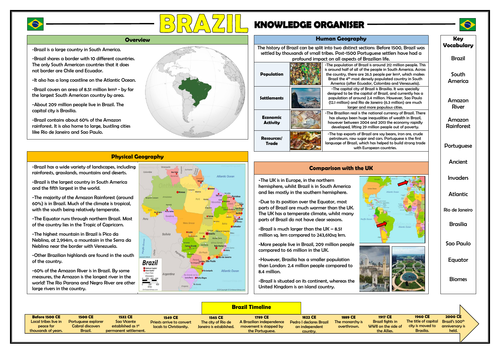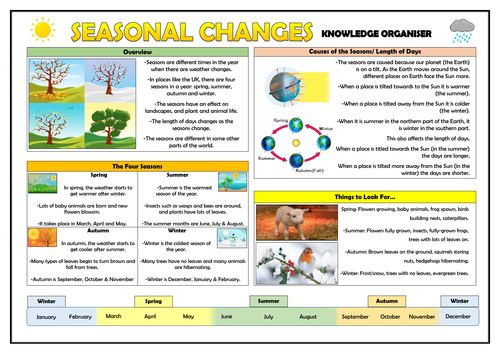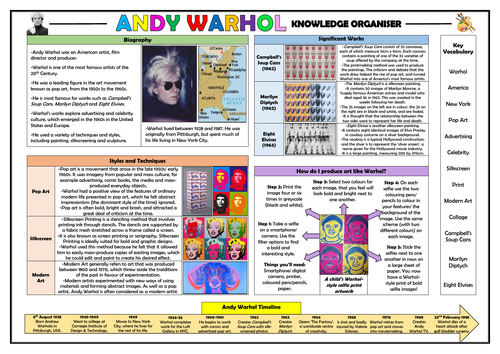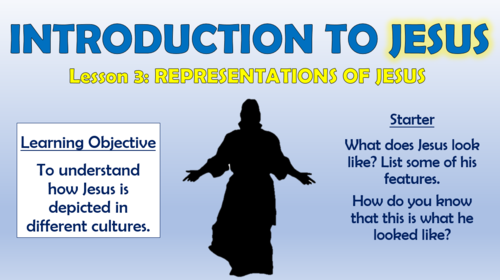
3k+Uploads
1858k+Views
2206k+Downloads
All resources

Writing Free Verse Poems - Upper KS2 Knowledge Organiser!
This clear, detailed and visually-appealing resource offers a complete reference point for year 5 and 6 children when writing free verse poems. The organiser is also perfect for teachers, parents and English subject leaders - aiding their planning and supporting of children’s knowledge development for this poetry form.
The organiser has a particular focus on the content, language and structural features required to write effective free verse poems. It contains distinct sections covering:
-Overview: Free verse poems;
-Content: What to include, the five senses, communicating a message, dramatic monologues and conversation poems, themes, messages;
-Language: Word choices, word types, alliteration, similes, metaphors, alliteration, onomatopoeia, personification, assonance, etc.
-Structure: Poem length, syllables, rhythms, line lengths, line breaks, stanzas;
-Key Vocabulary.
The resource was originally designed for upper KS2 children. It is designed to be printed onto A3 (however can also be printed in A4) and is provided as both a PDF and a Word version (so that you can edit if you want to).

Writing Kenning Poems - KS2 Knowledge Organiser!
This clear, detailed and visually-appealing resource offers a complete reference point for KS2 children when writing kenning poems. The organiser is also perfect for teachers, parents and English subject leaders - aiding their planning and supporting of children’s knowledge development for this poetry form.
The organiser has a particular focus on the content, language and structural features required to write effective kenning poems. It contains distinct sections covering:
-Overview: Kenning poems;
-Content: What to include, the five senses, communicating a message, kenning examples;
-Language: Word choices, word types, alliteration, hyphens, metaphors, alliteration and onomatopoeia, punctuation checklist etc.
-Structure: Poem length, line lengths, stanzas;
-Key Vocabulary.
The resource was originally designed for KS2 children. It is designed to be printed onto A3 (however can also be printed in A4) and is provided as both a PDF and a Word version (so that you can edit if you want to).

Writing War Poetry - KS2 Knowledge Organiser!
This clear, detailed and visually-appealing resource offers a complete reference point for KS2 children when writing war poems. The organiser is also perfect for teachers, parents and English subject leaders - aiding their planning and supporting of children’s knowledge development for this writing text type.
The organiser has a particular focus on the content, language and structural features required to write effective war poetry. It contains distinct sections covering:
-Overview: War Poetry;
-Content: What to include, tone, common features, word mat;
-Language: Vocabulary choices, poetic devices, rhyme, punctuation checklist;
-Structure: Stanzas, syllables, rhythm, rhyme scheme, top tips;
-Key Vocabulary.
The content is fully aligned with the age-related expectations for upper KS2 children in writing. The resource is designed to be printed onto A3, and is provided as both a PDF and a Word version (so that you can edit if you want to). All images used are licensed for commercial use and are cited on a separate document (included).

Patience Assembly!
This fun and original assembly aids children in understanding the value of being patient, through:
Understanding what patience is, and recognising why it is important;
Looking at examples of patient and impatient behaviour (including through personal examples and acting out an adapted version of 'The Tortoise and the Hare), and determining the impact that it has on the individuals and others around them;
Learning strategies to demonstrate patience in their own lives.
The session includes a comprehensive, engaging PowerPoint presentation, hyperlinks to relevant and interesting video clips, and both a PDF and Word copy of the script for the fable. There are also various discussion prompts to enable children to understand how they can be patient in different areas of their own lives.
The slides are fairly self-explanatory, but I’ve included guiding notes to assist the speaker. Hope that you find this useful!

The Magic Box - Whole Class Reading Session!
This whole class reading session aims to develop children’s comprehension of Kit Wright’s poem ‘The Magic Box.’
After children have read the poem together (included as a PDF), they partake in a series of activities aiming to develop their retrieval, explanation, inference and creating skills. It also contains a vocabulary check immediately after the extract is read to clarify any unfamiliar/ difficult language.
The tasks are comprised of quick-check questions, solo thinking, pair/ group discussions and deeper thinking activities.
The session is best suited for children in years 2-4, although with minor adaptations it could feasibly be used with slightly younger and older year groups.

Roald Dahl Knowledge Organiser!
This clear, detailed and visually-appealing resource offers a complete reference point for children learning about Roald Dahl, particularly those completing a history study of ‘Significant Individuals.’ It contains comprehensive sections entitled:
Overview;
Times in His Life;
Important Vocabulary;
Roald Dahl Timeline;
Answers to the Important Questions;
Top Ten Facts.
The resource is designed to be printed onto A3, and is provided as both a PDF and a Word version (so that you can edit if you want to). All images used are licensed for commercial use.

Out, Out - Robert Frost - Knowledge Organiser!
This detailed and visually-appealing resource offers a complete reference point for students learning or revising the Robert Frost poem 'Out, Out-.’ It contains comprehensive sections on:
Context;
Line-by-Line Analysis;
Poetic Devices/ Language Devices;
Themes;
Form/Structure;
Poems for Comparison;
More About the Poem.
Key words and ideas are underlined for easy reference. The resource is designed to be printed onto A3, and is provided as both a PDF and a Word version (so that you can edit if you want to). All images used are licensed for commercial use and are cited on a separate document (included).

DT: Food and Nutrition - Upper KS2 Knowledge Organiser!
This clear, detailed and visually-appealing resource offers a complete reference point for children, teachers and parents covering the ‘Food and Nutrition’ elements of your upper KS2 curriculum in Design and Technology. The organiser is clear, logical and fully meets the expectations of the National Curriculum.
It includes sections on:
-Preparing and Cooking Processes;
-A Healthy and Varied Diet;
-Where Food Comes From (including seasonality);
-Foods Around the World;
-Health and Safety Guidance.
The resource is designed to be printed onto A3, and is provided as both a PDF and a Word version (so that you can edit if you want to). All images used are licensed for commercial use and are cited on a separate document (included).

World War I Knowledge Organiser/ Revision Mat!
This detailed and visually-appealing resource offers a complete reference point for students learning or revising knowledge of World War I. It contains comprehensive sections on:
Major Events - dates, images, descriptions, and key facts;
Key People - Archduke Franz Ferdinand, David Lloyd George, Tsar Nicholas II, Woodrow Wilson, Kaiser Wilhelm II, Wilfred Owen;
Main Participating Countries - Flags, Year joined and death toll;
Timeline of Major Events.
Key words and ideas are underlined for easy reference. The resource is designed to be printed onto A3, and is provided as both a PDF and a Word version (so that you can edit if you want to). All images used are licensed for commercial use and are cited on a separate document (included).

Woman Work - Maya Angelou - Comprehension Activities Booklet!
This 16-page resource booklet contains a wide range of challenging and engaging comprehension activities for use throughout the reading of Maya Angelou’s poem ‘Woman Work.’ Teachers have found the activities particularly useful throughout teaching, or for exam revision or guided reading sessions. They are perfect for aiding the progress of students towards meeting the key English Literature assessment objectives - suitable for all examining bodies. Students have found these resources extremely engaging, and it is clearly highlighted within each task regarding which assessment strands the task is designed to demonstrate.
It is provided in both Word (to allow for easy editing) and PDF (to ensure for consistency of formatting between computers).
Activities within the booklet include (amongst many others):
‘Analysing Context’ - helping students to ‘Show understanding of the relationships between texts and the contexts in which they were written.’
‘Analysing Subject Matter, Language and Structure’ - to help students to ‘Analyse the language, form and structure used by a writer to create meanings and effects, using relevant subject terminology where appropriate.’
‘Diary Entry’ - to help students to ‘Use a range of vocabulary and sentence structures for clarity, purpose and effect, with accurate spelling and punctuation. Make an informed personal response, recognising that other responses to a text are possible and evaluating these.’
‘The Speaker’ - to help students to ‘Read, understand and respond to texts. Students should be able to: maintain a critical style and develop an informed personal response use textual references, including quotations, to support and illustrate interpretations.’

Victorians Non-Fiction Guided Reading Texts and Activities!
Included in this resource pack are three non-fiction information texts, with corresponding activities, about the following areas of Victorian life:
-Life for Rich and Poor Victorian Children;
-Chimney Sweeps;
-The Life of Queen Victoria.
The activities aligned with each text become progressively more difficult, allowing children to showcase different skills, including: retrieving, interpreting, inferring, identifying, analysing, evaluating and creating. This enables you to tailor the learning to children’s individual needs.
All files are provided as PDFs and Word files (in the zip files). I have previously used these resources with Year 3, 4, and 5 children.

The Atlantic Slave Trade - Knowledge Organiser!
This clear, detailed and visually-appealing resource offers a complete reference point for students learning or revising knowledge relating to the Atlantic Slave Trade. There are comprehensive sections on:
-Atlantic Slave Trade Overview;
-Atlantic Slave Trade Map;
-Major Events;
-Timeline;
-Features of the Slave Trade;
-Key Vocabulary;
-Top Ten Atlantic Slave Trade Facts.
The resource is designed to be printed onto A3 or A4, and is provided as both a PDF and a Word version (so that you can edit if you want to). All images used are licensed for commercial use and are cited on a separate document (included). It is most suitable for students in KS3.

Literacy Writing Mat (Openers, Vocabulary, Connectives, Punctuation, Common Mistakes)
This is the perfect resource for teachers looking to build students writing skills across the curriculum. Aiding students in the four key areas of their writing (Openers, Vocabulary, Connectives, and Punctuation) and also addressing a few common writing mistakes, my students now ask for this whenever they are asked to complete writing tasks, in any of their subjects. It is extremely visually engaging, and can also be used as a poster.
Nothing needs to be done to this resource. It is already in A3. Simply print off and laminate.
Alternatively, you can buy the Descriptive Writing Big Bundle (All descriptive devices lessons, structuring and organising writing lesson, capturing the readers attention lesson, and the literacy writing mat) for £4.

Harry Potter and the Philosopher's Stone - Lord Voldemort!
This engaging and informative lesson enables students to understand the key features of effective villains, as characterised by Lord Voldemort in J.K Rowling’s 'Harry Potter and the Philosopher’s Stone.' In particular, students highlight key character traits of Voldemort evident in Chapter 17 of Harry Potter and the Philosopher’s Stone (e.g. lack of empathy, hideous appearance, links to the hero, and a clear goal/objective), before utilising this understanding to create and describe their own effective villains.
The lesson follows a step-by-step learning journey, in which children learn through:
- Comprehending Voldemort's role in the novel leading up to the Chapter 17;
- Collectively defining the features of effective villains;
- Reading Chapter 17 of Harry Potter and the Philosopher's Stone, identifying and explaining his characterisation as a villain;
- Analysing the effectiveness of each of Rowling's techniques in creating the image of an effective villain;
- Creating and describing their own imaginative villains, utilising the features of villains effectively and imaginatively throughout;
- Peer assessing each other's learning attempts.
Included is:
- Whole lesson PowerPoint - colourful and comprehensive;
- Paper extract of Chapter 17 of Harry Potter and the Philosopher's Stone (freely available online);
- Lord Voldemort analysis template;
- Create Your Own Villain template;
-Comprehensive lesson plan.
All resources are provided in Word (for easy editing) and PDF (to ensure formatting remains fixed between different computers).
There are also opportunities for group learning, speaking and listening, peer assessment, and whole class discussion. I originally used these resources with year 7/8 classes, however colleagues have used them for between years 3 and 10 with some adaptations.
All images are licensed for commercial use, and image rights are listed on the last page of the presentation.

Stupendous Story Openings!
This engaging and informative lesson enables students to understand the key techniques used by writers when opening narratives, and to use these features in their own story openings. In particular, students analyse the features that make the openings to famous children’s narratives effective, before utilising this understanding to compose their own imaginative story opening.
The lesson follows a step-by-step learning journey, in which children learn through:
Collectively defining the features of effective story openings;
Reading the opening to several famous narrative opening examples, identifying the story opening techniques;
Analysing the effectiveness of each of the authors’ story opening techniques;
Creating their own engaging story openings, utilising story opening techniques effectively and imaginatively throughout;
Peer assessing each other’s learning attempts.
Included is:
Whole lesson PowerPoint - colourful and comprehensive;
The opening chapters of Mr Stink, Holes, and Harry Potter and the Philosopher’s Stone (freely available online);
Stupendous Story Openings analysis template;
Teacher answer sheet;
-Comprehensive lesson plan.
All resources are provided in Word (for easy editing) and PDF (to ensure formatting remains fixed between different computers).
There are also opportunities for group learning, speaking and listening, peer assessment, and whole class discussion. I originally used these resources with year 7/8 classes, however colleagues have used them for between years 4 and 9 with some adaptations.
All images are licensed for commercial use, and image rights are listed on the last page of the presentation.

Brazil Knowledge Organiser - KS2 Geography Place Knowledge!
This clear, detailed and visually-appealing resource offers a complete reference point for students revising knowledge relating to Brazil, as a part of their study of place, human and physical geography (‘understand geographical similarities and differences through the study of human and physical geography of a region of the United Kingdom…and a region of South America.’)
I coupled this with our learning of rainforests, to provide children with a more in-depth understanding. It contains comprehensive sections on:
Overview and Maps;
Physical Geography;
Human Geography;
Comparison with the United Kingdom;
Brazil Timeline;
Key Vocabulary.
The resource is designed to be printed onto A3, and is provided as both a PDF and a Word version (so that you can edit if you want to). All images used are licensed for commercial use and are cited on a separate document (included).

Year 1 Seasonal Changes Knowledge Organiser!
This clear, detailed and visually-appealing resource offers a complete reference point for Year 1 children, teachers and parents covering knowledge relating to ‘Seasonal Changes’, as a part of their science learning. It contains comprehensive sections on:
Overview;
The Four Seasons;
Seasons Over the Calendar Year;
Cause of the Seasons/ Length of Days;
Things to Look For;
Key Vocabulary.
The content is fully aligned with the NC expectations for Year 1 children relating to ‘Seasonal Changes:’
-observe changes across the four seasons
-observe and describe weather associated with the seasons and how day length
varies
The resource is designed to be printed onto A3, and is provided as both a PDF and a Word version (so that you can edit if you want to). All images used are licensed for commercial use and are cited on a separate document (included).

Year 6 Light Knowledge Organiser!
This clear, detailed and visually-appealing resource offers a complete reference point for Year 6 children, teachers and parents covering knowledge relating to ‘Light’, as a part of their science learning. It contains comprehensive sections on:
Overview;
How We See Things;
How Light Travels;
Our Eyes;
Light Spectrum;
Key Vocabulary (underlined).
The content is fully aligned with the NC expectations for Year 6 children relating to ‘Light:’
-Recognise that light appears to travel in straight lines;
-Use the idea that light travels in straight lines to explain that objects are seen
because they give out or reflect light into the eye;
-Explain that we see things because light travels from light sources to our eyes or
from light sources to objects and then to our eyes;
-Use the idea that light travels in straight lines to explain why shadows have the same shape as the objects that cast them.
The resource is designed to be printed onto A3, and is provided as both a PDF and a Word version (so that you can edit if you want to). All images used are licensed for commercial use and are cited on a separate document (included).

Andy Warhol Knowledge Organiser!
This clear, detailed and visually-appealing resource offers a complete reference point for students learning about the artist Andy Warhol, as a part of their art and design study.
It contains comprehensive sections on:
-Biography of the Artist;
-Styles and Techniques;
-Andy Warhol Timeline;
-Significant Works;
-Key Vocabulary;
-How do I create art like Warhol?
This resource can be adapted for all ages, but was originally designed for KS2 and KS3 children.
The resource is designed to be printed onto A3, and is provided as both a PDF and a Word version (so that you can edit if you want to). All images used are licensed for commercial use and are cited on a separate document (included).

Introducing Jesus - Representations of Jesus!
In this engaging lesson, students develop their understanding of how Jesus Christ is visually depicted in paintings, focusing on facial expression, body language, his effect on his immediate environment, and other features. They also begin to look at how Jesus has been depicted over time and in different cultures.
The learning is guided by a clear and colourful PowerPoint presentation, which guides students through the following step-by-step journey:
-Personal Spirituality - considering how people (including themselves) can be represented;
-Understanding how no one today knows for sure how Jesus looked, and the paintings that we see of him are artists’ representations;
-Analysing how Jesus is represented in some famous paintings of different events in his life;
-Creating their own painting of Jesus from an event in his life, considering how Jesus himself is represented.
This resource pack contains a comprehensive Powerpoint, alongside an eye-catching, and helpful worksheet.
In the past, I have used this lesson with children from across Key Stage 2 - the key learning is aligned with curriculum expectations for RE, and also the content prescribed by most diocese regions. All images are licensed for commercial use.

